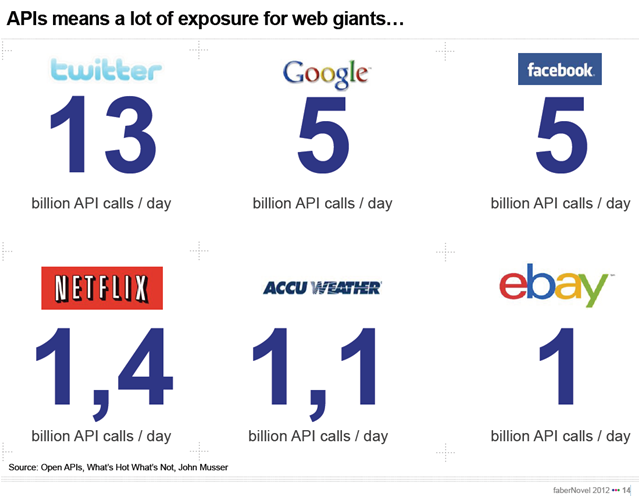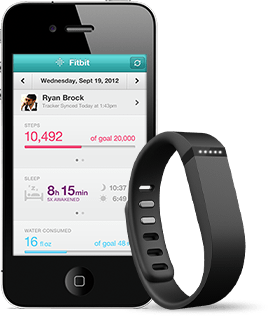Spread the business model of open innovation using the API
- Transfer

Open innovation can be steadily supported by the Application Programming Interface (API) and take advantage of this “collaboration”. The API not only stimulates the development of innovations, but also forms new revenue streams, strengthens your marketing campaigns and expands the scope of the applied business model. It's time to understand that an API is needed for your business.
API “Keeps Secrets” Better Than All
At the API days conference last December, @CyrilVart (@Fabernovel) showed a comprehensive presentation of “6 reasons why APIs are reshaping your business”. Let’s take a closer look at it and, combining the information received with our own experience, will appreciate what this new exciting area has to offer.
An API is a protocol that is used by software components as an interface to communicate with each other. In other words, an API is a connecting element between functional components that connect to each other like Lego constructor blocks.
Does the API still seem to you something wild and distant?

Think again, some APIs are pretty well known, we just don't call them that.
- The Facebook Like button, which is designed to shape the structure of public recommendations, is based on the API, i.e. you can enter it on your website just by inserting a simple line of code.
- The Twitter interface, among other features, also allows you to display tweets in other applications, it is used about 13 billion times a day, and more than a thousand applications were based on the Twitter interface.
- The Google API (including the Google Maps interface, which supports a landmark on a map on many web sites, or the Google Adsense interface, which allows advertisers to automatically upload text, images, video, and rich media ads to Google’s network sites) is asking for 5 billion a day.

Team Innovation API
API promotes innovation. We placed the API at the center of the Modular Design and Rapid Innovation model. This brought a number of useful results:
- Acceptance: API modules facilitate the adoption of innovations, transferring control to other participants in the process, allowing them to feel their involvement and set their own parameters based on your platform.
- Collective creativity: the API does not impose anything on anyone, but rather encourages you to create, this is the so-called “set of tools for design”, a practical embodiment of the principle “Create with someone, not for someone.”
- Flexibility: due to the fact that these applications are created for the end user and the API components are fragmented, the API development team is given complete freedom of action.
- Speed: The API accelerates innovation by enabling parallel code execution. The component can be used as a center that receives parallel connections from different applications.
- Multifunctional development: the requests of various applications cooperate and expand the functions of the component within the mechanism of self-improvement of innovations. The progress of each participant benefits everyone

Fabernovel attaches great importance to the similar valuable contribution of API to the development of production: “API is a software module that allows someone to share data, content and functionality with others, giving others the chance to create new services based on this data, content and functional opportunities. " This view is reinforced by Fitbit., a player in the market of “smart” things: Fitbit is a fitness tracker that captures health indications and data on training progress; It was created based on the API to enable third-party developers to create fitness applications using Fitbit data, that is, information such as distance traveled per day, calories burned, amount of food consumed, and weight. On the basis of the Fitbit interface, 20 applications were created using innovative approaches to the application of the obtained data on the progress of training and health indicators.
Instead of thinking about the development and implementation of Research and Development [R&D Eng. Research and Development, R&D] with the help of the API, it is better to perceive the API as a tool for using collective intelligence that can attract many people's abilities: the larger the eyes, the easier they will find and correct mistakes, and therefore improve the ecosystem.

According to Professor Chesbrough: “The Open Innovation model involves using other people's resources to move on our own.” When Open Innovation breaks the borders, there is no better currency than API to find innovative technology in the outside world.
APIs in common business models
In addition to fostering innovation, Fabernovel mentions five key business outcomes of using the API:
- New sources of income
- New distribution channels
- Expanding partnerships
- Fine-tuning management (the API does not open access to everything, but allows a lot of control)
- Organizational flexibility (using internal APIs allows you to redefine the role of IT and accelerate teamwork)
All of these effective stimulants allow the API to expand your business: an API is more than just a bunch of components.

I picked up several iconic companies that managed to use the full potential of the API:
- Expedia opened an API for its partners to have access to orders, photos, search results, customer reviews: today, the network of sister organizations of Expedia has 10,000 companies and has annual revenues of $ 2 billion, 90% of which are received through the API.
- Based on an API that provides a range of CRM services in the cloud, Salesforce has built a powerful business model that is not tied to a physical point of sale and local software installation.
- Netflix opened the API in 2008 to allow developers to use the company's resources (movie catalog, queue management, rental history) and create a creative business: today more than 800 devices can play Netfix content and about 20,000 developers use their API.
- Facebook Connect allows users to log in to many other sites using their Facebook profile. Third-party developers can add the "Sign in with Facebook" button using the Facebook Connect API. The Facebook Connect interface has standard registration data, with the help of which a universal ID for the digital world is generated and, moreover, allows Facebook to build partnerships on a global scale, spending a minimum of money.
- Amazon web services offer a wide range of services (storage services, databases, computing power, servers, application services, deployment and management) available through a set of APIs. A fee is charged for working with each of these services, which means that Amazon very clearly monitors the experience of using the service for each client. In 2011, the company earned $ 750 million.
- Comcast, America’s largest cable provider, has created dozens of internal APIs so teams can easily share data and solutions. Today, teams can create a new product and evaluate the user experience faster than ever, thus creating new sources of revenue for Comcast. To share resources through the internal API, you need only 30 minutes, and not a month, as it was before.
- AT&T is now offering 79 APIs to third-party developers (Future Center Blogs), while Orange has redesigned its Orange Partner affiliate site to showcase its API.

“Working with the API is as natural as breathing.”
The API family is expanding: Marc Andreessen distinguishes between the viewed API, the plug-in API, and the online API, where third-party code is run inside the platform, and it is this view of Andressen that defines how most promising.
Developing an API will help you focus on your core business, as well as on the use of collaborative innovations, creating new business flows, by connecting the already mentioned functional “Lego blocks”: “when every business is an API, new companies can be formed almost instantly, by simply joining ”, Says Mark Pesce. API is a strategic tool for reorganizing your business.
Having tried to apply it once, you will not stop. In my case, since I started a new innovative project, I have unconsciously thought of two products: the end-user oriented service and the corresponding API. Each of them requires its own approach to design in order to gain importance that is consistent with the goals of users.
Developing an API for your business opens up a new path for your company and a new scale of activity: the future system consists of many small independent components, and also uses any type of connected object to exchange resources, company growth can happen at lightning speed.
“We are witnessing the 'Business Process API", says Robin Vasan. This is a process during which enterprises are forced to reorganize themselves as an API ( @mpesce ). Now is the time for innovators to enter the game, and sellers to start thinking in terms of APIs.
